Hong Kong March 2 & 3, 2017
First an update on the time of day reported by my cell phone. It remained happily on Honolulu time until we got to Osaka, then decided that Japanese time was great. However, that lasted until we were almost to Korea when it decided that maybe it should drop back to Honolulu which is 8 hours behind China. (EST zone is 13 hour behind China) The phone is still reporting Honolulu Time.
Hong Kong is an island that is only 427 miles square. Despite this, it has a population of over 7.3 million which explains all the high rises. It is directly across from Kowloon which is contiguous with the New Territories and mainland China. All three were British Colonies with Hong Kong being British for 150 years and the other two for about 100. All three, and Macau, a former Portuguese colony, reverted to China in 1997. They both are “Special Administrative Regions,” which will revert to becoming part of China in 2047. Theoretically they are autonomous, but China is not living up to its agreement and in elections, only those who are approved by Beijing can run.
That little piece of land in the upper left of Lantau Island is where the new airport is - all on reclaimed land.
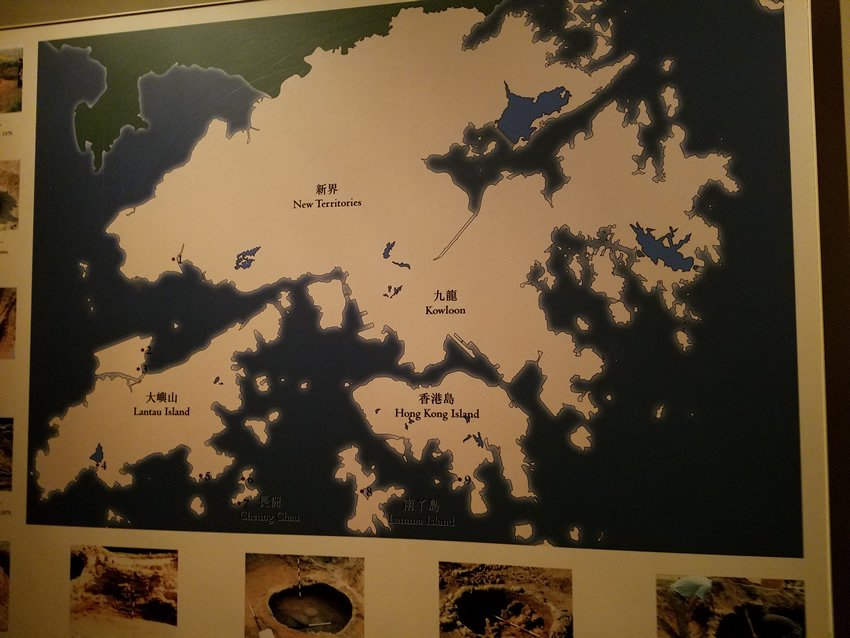
When Beijing decided that only those approved by them could run for election, there were protests, the main one is the umbrella protest which began in 2014 with the umbrella as its official symbol. There were tent cities with protestors, one of which lasted 2.5 months before the officials broke it up. Supposedly this protest movement ended in December of this past year. However, it is still underground. Some of the more extreme elements want independence from China, which is never going to happen. The original protest fizzled because it interfered with the lives of the majority who, despite initial support, wanted their usual lives.
Entering Hong Kong via Victoria Harbor was an exercise in picture taking. There are mountains and high rises both in Kowloon and Hong Kong. Notice that there is nothing special about the buildings, after Shanghai we were impressed only with the numbers of them, not the architecture. In the foreground of the picture below is the typhoon shelter for small boats during their once a year expected typhoon. The picture below is of the Kowloon side.
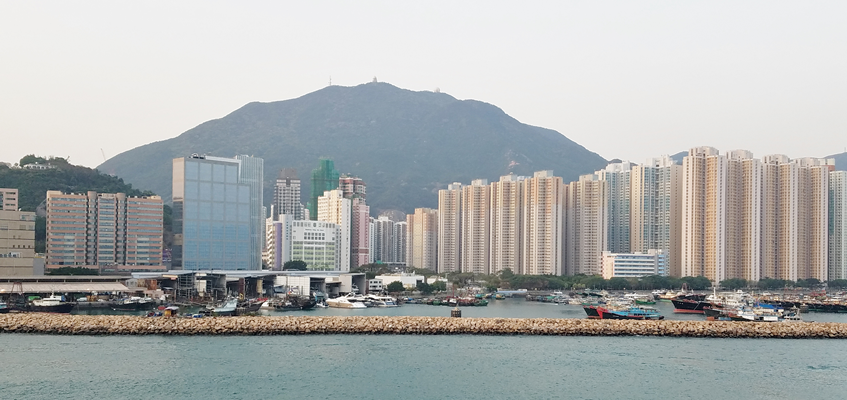
We docked the first day at Kai Tek Ocean Terminal in Kowloon which was the old airport. Unfortunately it is not near anything that one wants to see… The terminal itself requires miles of walking just to go from the ship to the bus.
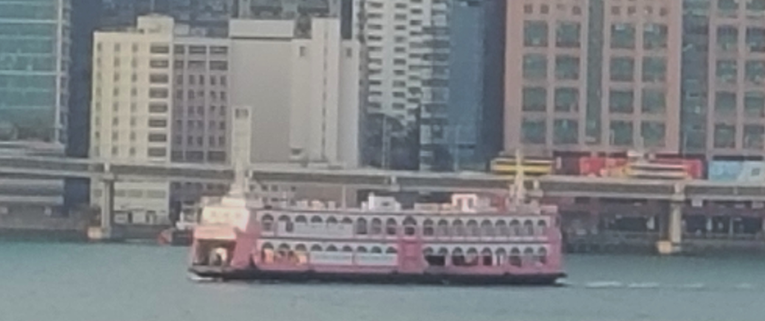
The first stop on the first day's tour was the Star Ferry Terminal so we could ride the famous Star Ferry. In the last 13 years it has become more or less a tourist attraction. There was a new subway/elevated train that opened just this past December so the locals use that as well as tunnels. As a tourist I enjoyed the ride over with the views of Hong Kong, skyscrapers and mountains!

Once on the island, as a good tourist, we had to take the tram to Victoria Peak. 13 years ago the tram cars were smaller and had benches that could seat 4 to 5 one facing up and the other facing down. This car was more like a trolley. The pathway to the top is in many places cut through rock. But that is Hong Kong - rock!
We were blessed with beautiful weather. After Beijing where we froze I think that Hong Kong decided to make up for Beijing and treat us to the low 70s and a beautiful blue sky. Our guide said that this weather was a welcome relief from the rain that they had been having.
After the obligatory picture taking of the spectacular views from the Peak, and on a day like what we had. the scenery virtually screams, “Take my picture,” again and again. Below is just one of many views of Hong Kong in the foreground and Kowloon across Victoria Harbor.

Stanley Market on the other side of the island was our next stop. We went by Repulse Bay which is now full of high rises, 13 years ago it was still a sleepy little beach, but there was construction going on then. It is one of the high rent districts - among many on this island.
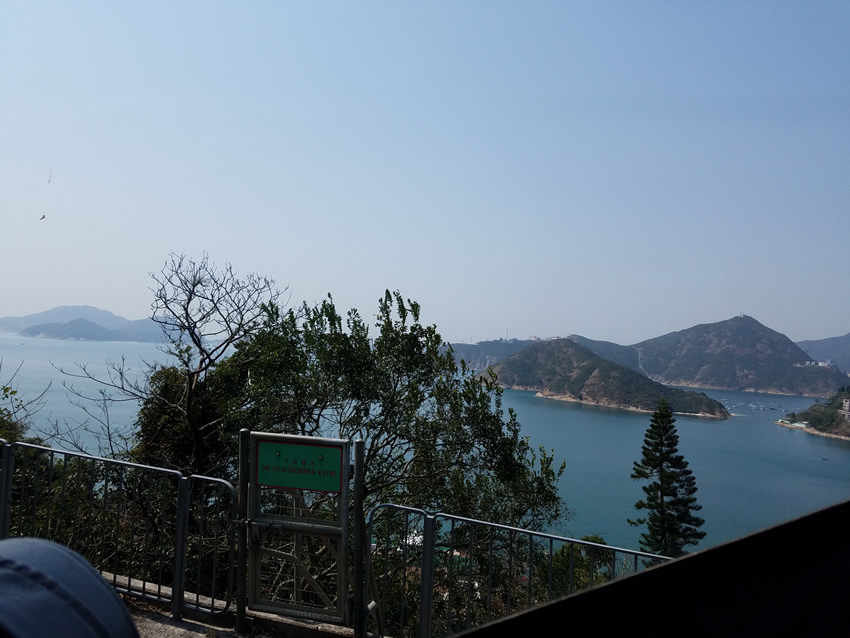
The above is a view on the way to Stanley Market.
Stanley Market is a colorful and fun market with a lot of inexpensive shops. For once we had time to explore. We also had lunch on our own. One of my colleagues and I had piazza and beer – and both were very good. We passed a place where a Mexican Restaurant is under construction and suppose to open this month.
Stanley Market is on a bay which was very peaceful and pretty for our visit. The Bay is surrounded by Mountains. Hong Kong is just big mountains and reclaimed land.
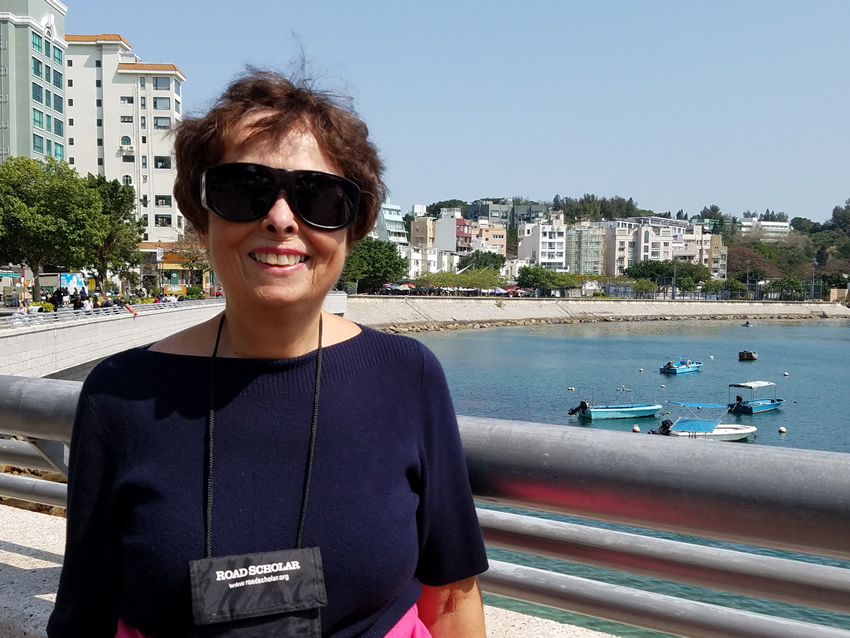
Me at the beach at Stanley Market. Not Photo Shopped, I really was there.
The road from the Peak to and from the Market afforded more beautiful views. It reminded me of the trip that Dex and I took many years ago on Highway 1 from Seattle to Los Angeles. When I was driving we would come around a curve and I would say to Dex, “What do you see?” “Just another beautiful view was the reply.” Hong Kong is a photographer’s paradise and even more so on days like the one we had.
A problem they have with these roads hewn into the rocks is landslides. In many places they have put netting up on the sides of the mountain – which is the side of the road. Some of my colleagues got motion sickness on the trip back from the Market. I just wish that there were places to pull off and take a picture - but when a road is cut from the mountain...
We took the harbor tunnel back to Kowloon. Although Kowloon has a spectacular laser light show at 8 each night that lasts for 15 minutes, and the ship provides shuttle buses there and back, we were all too tired to go. Shanghai spoiled us.
I had heard that the Chinese often use saffolding made of bamboo sticks tied together - and I actually saw this. There was a high rise under construction on one of our bus trips and the scafolding was just that. I wanted to take a picture, but you could not see it. Apparently the bamboo is very strong. Because it is light it is also eay to move.
The ship moved about 11 o'clock our first night to the more popular dock near the Star Ferry from which we could have seen the light show from the ship, but alas we left the second night before the show.
The last day in Hong Kong we went to the Hong Kong Museum of History. There is a carefully executed number of exhibits starting with number 1 that provides information about how the island formed. Eventually it progresses to the volcano which created all these islands - there are more than 200 of them. Interestingly they do not have earthquakes here, but instead typhoons.
Finally the exhibits featured the opium wars. I thought that they were kind to us Western Powers who really did them in creating addicts of their people and fighting wars for the right to do so. A later exhibit provided information about the Japanese Invasion and the difficult times the people here had. The military people were put into concentration camps, some Chinese were shipped to desert islands with no food and no way to survive and starved to death.
As is always true with populations that are conquered, there were collaborators. There was also guerilla warfare, organized by the Chinese Communist Party.
The last exhibit had a video about the hand over by the British to the Chinese, but I did not have time to view it. The guides were so insistent that we start with exhibit 1, and refused to tell us where to see this video, that by the time we got to it we had to leave. Most of us would have viewed it first just for this reason, but they would not tell us how to get there. As it was all but one of us missed it and he held the bus up to watch it.
It is a great museum, but 2 hours was hardly enough time to see it, try 2 days! The exhibits are wonderfully done including full scale panoramas of scenes from various times. I was particularly interested in the scale models of both a shrimper and a fishing trawler whose methods are the same as those used today. Below is a fishing trawler
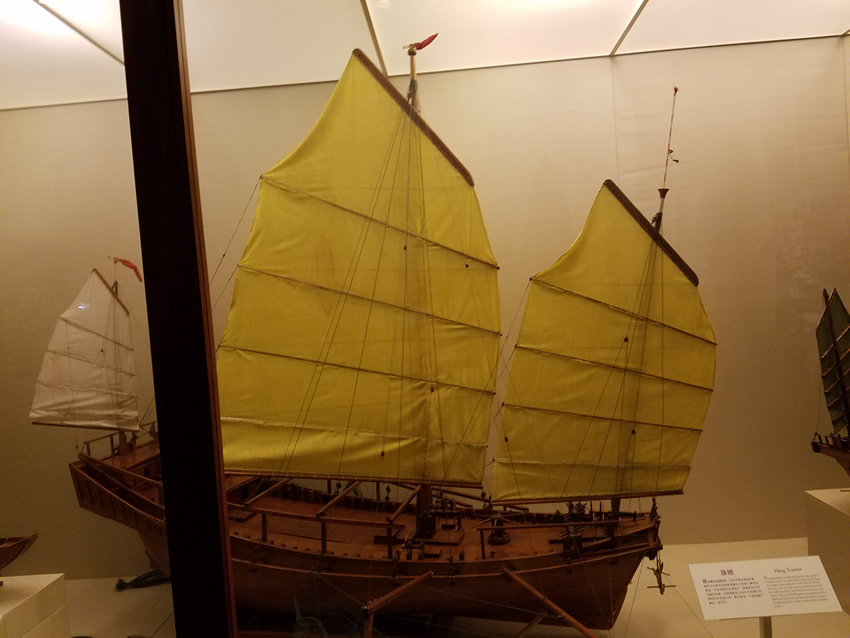
In our Euro centric History classes we never learned that the Chinese in the 1400s and 1500s had a wonderful navy. There ships were 7 times the size of Columbus's ships. But after visiting ports through Cape Town they came to the conclusion that there was nothing of any value there so there was no sense in trading. After a long expedition an emperor decided that a navy cost too much and stopped the foreign explorations and closed China's ports.
Wouldn't life have been interesting if the Chinese had discovered the new world...
And now we are underway with two sea days ahead on our way to Vietnam and HOT weather... The location guide remarked that she knows that soon someone will tell here to bring back the snow from Beijing.
History
Just a brief return to China itself. A speaker on the ship, who had lived in China in 1986 and has returned many times since, said that the Chinese are now better off than they have ever been before. Their income has increased tenfold which gives them security. They can travel, they spend a billion and a half each year on travel, a lot of it out of the country. Although access to political news is blocked they have access to more information than ever before.
In what is suppose to be Hong Kong history I will not reiterate the opium wars except to say that the Treaty of Nanking in 1842, after the first one, found Hong Kong ceded to the British. Lord Palmerston disgustedly remarked, “It’s nothing but a barren island with hardly any houses on it.” He should see it today. With its many coves and islands it was a Pirate Haven until the early 1900s.
Make no mistake, the opium trade that gave Britain control of Hong Kong for 150 year was HUGE. Britain had large factories in NE India and had special ships built to carry it to China. It financed the British empire. Many entrepreneurs who today run reputable businesses, at least on the surface, got their start selling opium. Sutherland who started the HSBC began as a clerk for the Pacific Oriental Navigation Company. Today this is the parent of many corporations including Carnival Lines which owns Holland America… Matheson and Jardine shipping company is another.
As you might expect, Hong Kong was, and still is, a mixture of cultures. Not just Chinese and British, but Indian, Philippine, and other SE Asia countries contributed population.
Even before the Communist takeover in China, it was a haven for revolutionaries. After the failed Tai Peng revolt, disaffected Chinese fled there. Dr. Sun Yat Sen, who wanted a Chinese Republic, took refuge there as did Ai Quoc who started the Chinese Communist Party. In 1949 many Chinese fled there as did the financial centers from Shanghai. Hong Kong was inundated with people and it wasn’t until the Chinese government put a stop to it that they could even begin to solve the problem of what to do with the refugees. The British did build apartment houses for them.
In the 1920’s Hong Kong was known as “The Decadent Colony.” Despite official British law, the real power in Hong Kong was the Hong Kong Jockey Club followed by the HSBC, and finally the Governor. Somerset Maugham use to visit there, stay with a couple, eat their food, drink their wine, and in general take advantage of them. He would then return to the UK and write novels about Hong Kong, often portraying the inhabitants in a negative manner. One novel, The Painted Veil, in which he portrayed his hosts for that visit in a very negative and identifiable manner caused the couple to sue, eventually winning 268 pounds.
Hong Kong fell to Japan on Christmas Day 1941 referred to by natives as “Black Christmas.” Returned to the British in 1945 it has since experienced a renaissance. Despite all the buildings, the architecture is pretty tame after Shanghai.
But like so many places, you need to be here to really soak it up.